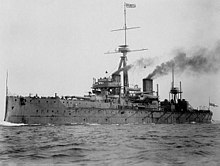Capital ship

Capital ship is the name for the artillery most powerful surface warships since the beginning of the 20th century. Capital ships had a displacement of 20,000 to 60,000 tons and were characterized by the main artillery carried with them, initially with ten to twelve guns with a caliber of 30 cm in five to six turrets. This firepower was later increased by eight to twelve guns with a caliber of up to 46 cm in three to four turrets. The armor, range and speed increased until the end of the Second World War , when the defenselessness of these ships against attacking aircraft or torpedoes became apparent. The effective range of a capital ship was limited by the range of its guns of up to 40 km and by the available target observation options (visual, radar ).
history
Dreadnought
The HMS Dreadnought can be considered the first capital ship. At the same time, the keel line stepped back as a tactical formation, because the opportunity for battles in which entire fleets met, dwindled. Instead, especially in the Second World War, large-scale sea areas had to be controlled by strong combat units, whose main power was represented by one or more capital ships, until these were replaced by aircraft carriers .
Battle cruiser
Battlecruisers can also be considered capital ships , which differ from the conventional battleship primarily in their superior speed, for which weaker armor or a reduced number of main guns was usually accepted. The first battle cruisers such as the HMS Invincible carried two guns less than the battleships of the Royal Navy introduced at the same time (eight instead of ten 30.5 cm guns).
Fast battleships
Between the world wars, battleships and battle cruisers were merged into the new type of fast battleship , which combined the advantages of both types. The battleships now had enough propulsion power to take on the tasks of battlecruisers and thus combined the advantages of high speed, strong armor and heavy armament.
The end of the capital ships
During the Second World War, capital ships were increasingly endangered by aircraft with bombs and torpedoes , so that they had to be protected by escort ships and immense anti-aircraft weapons . After the Second World War, their military importance disappeared almost completely, because on the one hand they were too sensitive to modern guided weapons and on the other hand were very limited in their tactical importance.
The last military missions carried out by capital ships were coastal bombing in the Vietnam War in the second half of the 1960s, the shelling of Beirut by USS New Jersey in 1983/84 and bombing by cruise missiles in the Second Gulf War in 1991 by American battleships that were still in the Second World War I had been built.


